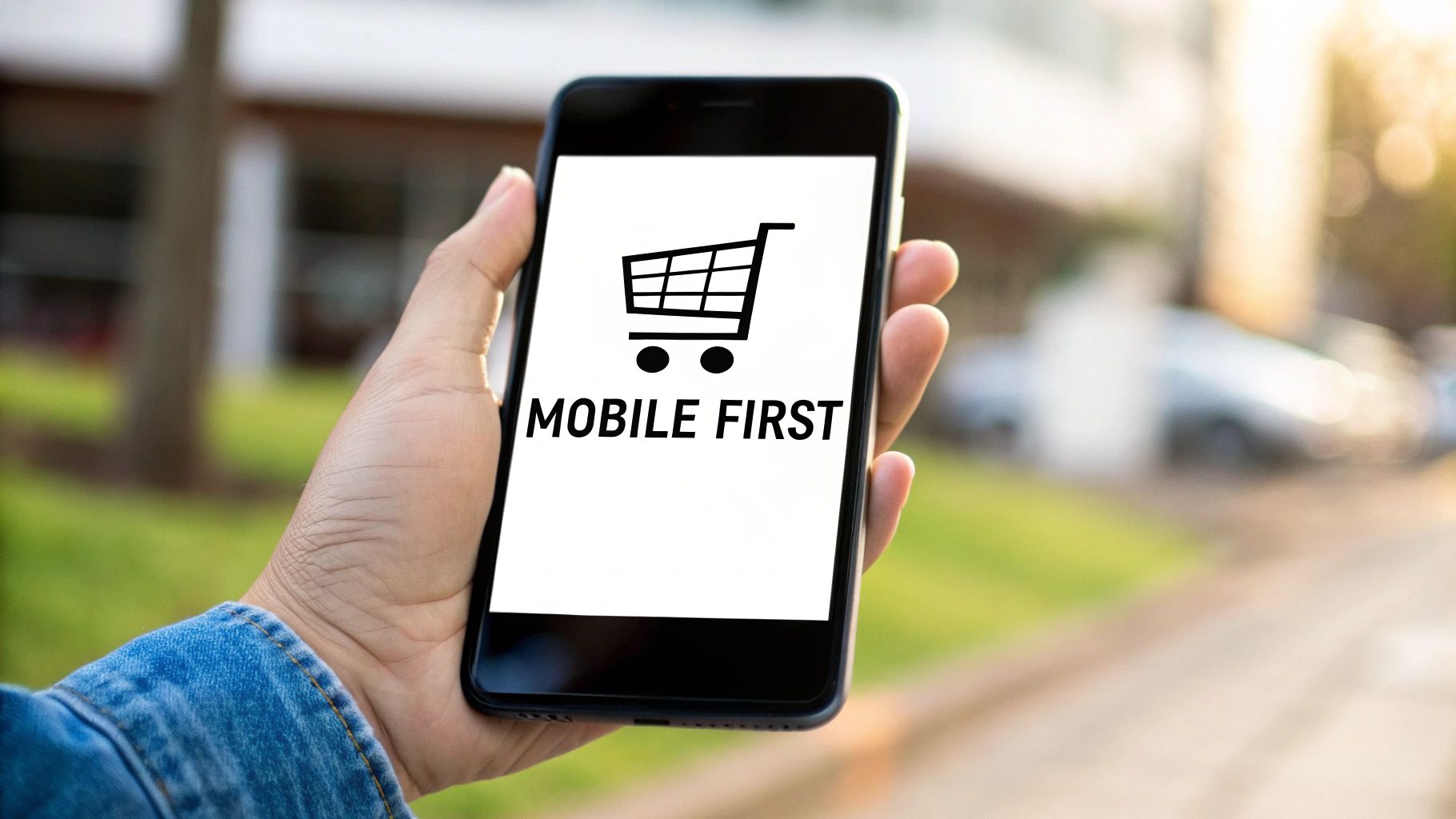In the hyper-competitive digital marketplace, simply having an online store isn't enough. Lasting success hinges on visibility—ensuring your products appear precisely when and where customers are searching. This demands a sophisticated, multi-faceted approach to search engine optimization that transcends basic tactics. Achieving this visibility is the central challenge for any online business, from established technology brands to growing hospitality companies aiming for more bookings.
This guide moves beyond generic advice to provide a comprehensive roundup of the most impactful ecommerce SEO strategies. We will explore the critical pillars of online retail success, from technical site health and on-page precision to strategic content marketing and authoritative link building. Each strategy is designed to be actionable, blending expert-level insights with clear instructions that are accessible to a wider audience. This helps you build a powerful SEO foundation that not only attracts traffic but converts it into revenue. For more insights, consider exploring data-driven marketing strategies. For a truly comprehensive approach to achieving top search rankings, consider following an SEO Domination Blueprint.
You will learn how to master key areas including:
- On-page optimization for product and category pages.
- Technical SEO essentials like site speed and mobile-first indexing.
- Off-page strategies such as link building and local SEO.
- Advanced techniques involving schema markup and voice search.
Whether you're refining an existing strategy or building one from the ground up, this article presents a clear blueprint. These nine proven methods will set your ecommerce business on the path to increased visibility, higher organic traffic, and sustained sales growth. Let's dive into the strategies that will help your store dominate the search results.
1. Product Page Optimization
Product page optimization is the cornerstone of any successful ecommerce SEO strategy. It involves meticulously refining every element on an individual product page to maximize its visibility in search engine results for highly specific, purchase-intent keywords. Think of each product page as a dedicated landing page engineered to attract and convert shoppers looking for that exact item. When executed correctly, this strategy ensures your products don't just exist on your site; they actively compete for top rankings on Google.

This granular focus is crucial because shoppers searching for specific products (e.g., "men's Nike Air Zoom Pegasus 40 running shoe size 11") are much closer to making a purchase than those using broader terms. Effective customer retention strategies can further amplify the lifetime value of these high-intent shoppers. By optimizing for these long-tail keywords, you capture high-quality traffic with strong commercial intent. Major retailers like Amazon and Best Buy have mastered this, creating detailed pages that function as comprehensive resources, complete with specs, reviews, and Q&As, which both users and search engines love. You can explore how increased visibility directly increases sales in our detailed guide on ecommerce SEO.
Key Implementation Steps
To effectively optimize your product pages, focus on these core components:
- Compelling Titles and Descriptions: Your page title tag is your primary opportunity to grab attention. Include your main keyword, brand name, and a unique value proposition (like "Free Shipping") within the ideal 60-character length. Your meta description should function as ad copy, compelling users to click with a clear call-to-action.
- Unique Product Descriptions: Avoid using generic manufacturer descriptions. Write unique, engaging copy that highlights benefits, not just features. Use bullet points to list key specifications, making the information easy to scan.
- High-Quality Visuals: Use high-resolution images and videos from multiple angles. Name your image files descriptively (e.g.,
blue-suede-loafers-front-view.jpg) and use descriptive alt text to improve accessibility and image search rankings. - Structured Data (Schema Markup): Implementing product schema helps search engines understand critical information like price, availability, and review ratings. This can result in rich snippets in search results, significantly boosting your click-through rate.
2. Technical SEO for Ecommerce
Technical SEO is the critical foundation upon which all other marketing efforts are built. It involves optimizing your site's backend infrastructure to ensure search engines can efficiently crawl, index, and understand your content. Think of it as building a super-fast, logically organized warehouse; if the corridors are blocked or the lighting is poor, no one can find the products. A solid technical framework is a non-negotiable element of modern ecommerce SEO strategies, directly impacting user experience and search rankings.

This behind-the-scenes work is essential because even the best product pages and content will fail if Google's crawlers can't access them or if the site is too slow for users. A slow or poorly structured site leads to high bounce rates, which signals to search engines that your site provides a poor experience. Platforms like Shopify and BigCommerce popularize strong technical SEO by building many best practices directly into their systems, while platforms like Magento offer deep customization for businesses needing advanced technical control. You can use Google’s own tools to benchmark your site’s health, as outlined in their guide on Core Web Vitals.
Key Implementation Steps
To build a technically sound ecommerce site, concentrate on these foundational pillars:
- Prioritize Site Speed: Page load time is a confirmed ranking factor. Aim for load times under three seconds. Use tools like Google PageSpeed Insights to diagnose and fix performance bottlenecks. Compressing images, leveraging browser caching, and minimizing code are essential first steps.
- Ensure Mobile-First Indexing Compliance: With most traffic now coming from mobile devices, your site must be perfectly responsive and functional on all screen sizes. Google primarily uses your mobile site for indexing and ranking, so its performance cannot be an afterthought.
- Optimize Crawlability and Indexability: Use a clean, logical URL structure and submit an XML sitemap to Google Search Console. Employ a
robots.txtfile to guide search engine crawlers, telling them which pages to crawl and which to ignore, preventing wasted crawl budget on irrelevant pages like admin logins or internal search results. - Implement a Secure Foundation (HTTPS): An HTTPS certificate (SSL) is mandatory. It encrypts data between your customers' browser and your server, building trust and satisfying a key Google ranking signal. Ensure all site versions (HTTP, HTTPS, www, non-www) redirect to a single, canonical version to avoid duplicate content issues.
3. Category Page SEO
Category page SEO is a powerful middle-of-the-funnel strategy that bridges the gap between broad homepage queries and specific product searches. It involves optimizing your category or collection pages to rank for higher-volume, discovery-oriented keywords. While product pages target long-tail, purchase-intent searches, category pages capture users who know what type of product they want (e.g., "women's running shorts") but haven't decided on a specific item yet. Mastering this is a vital component of a comprehensive ecommerce SEO strategy.

This approach is crucial for capturing a significant share of search traffic and guiding users through their buying journey. By creating a user-friendly hub for a group of related products, you improve site navigation and create substantial ranking opportunities. Retail giants like Home Depot and ASOS excel at this by enhancing their category pages with helpful content, buying guides, and trend reports, turning them into valuable resources that attract both shoppers and authoritative backlinks.
Key Implementation Steps
To transform your category pages into SEO powerhouses, implement these targeted actions:
- Write Unique Category Descriptions: Go beyond a simple grid of products. Write a unique, keyword-rich introductory paragraph at the top of the page. This content provides context for search engines and helps users understand the scope of the products offered.
- Optimize Titles and Headers: Your page title and H1 tag should target your primary category keyword (e.g., "Men's Leather Wallets"). Ensure it's clear, concise, and aligns with user search intent for that product group.
- Implement Smart Faceted Navigation: Use faceted navigation (filters for size, color, brand) to enhance user experience. Crucially, manage the crawl budget and avoid creating duplicate content by using
rel="nofollow"on filter URLs or blocking them inrobots.txtto prevent indexing of countless variations. - Use Clean URLs and Breadcrumbs: Structure your URLs logically (e.g.,
yourstore.com/shoes/running-shoes). Implement breadcrumb navigation to improve user orientation and help search engines understand your site's hierarchy, spreading link equity more effectively.
4. Content Marketing for Ecommerce
Content marketing is a dynamic component of ecommerce SEO strategies that extends beyond simple product pages. It involves creating and distributing valuable, relevant, and consistent content to attract and retain a clearly defined audience, ultimately driving profitable customer action. Instead of directly selling, you provide useful information that solves your audience's problems, builds trust, and establishes your brand as an authority in its niche. This approach captures users at the top and middle of the sales funnel, nurturing them toward a purchase.

This strategy is essential because many potential customers aren't ready to buy immediately. They are searching for information, comparisons, or solutions (e.g., "how to choose a running shoe for marathons" or "best skincare routine for dry skin"). By creating content that answers these questions, you attract organic traffic that might otherwise never find your product pages. For instance, REI excels with its extensive library of expert advice on outdoor activities, while Sephora’s Beauty Insider Community provides tutorials and guides that seamlessly link to the products used. As your content library grows, maintaining momentum is key; to keep up with demand and maintain growth, explore effective scalable content creation strategies.
Key Implementation Steps
To launch an effective content marketing program, focus on these strategic actions:
- Target Informational Keywords: Use keyword research tools to identify long-tail informational queries your target audience is searching for. These are often phrased as questions, such as "how to," "what is," or "best x for y."
- Create High-Value Content: Develop comprehensive blog posts, detailed buying guides, video tutorials, and downloadable checklists. The goal is to create the best possible resource for a given topic, establishing your site as the go-to authority.
- Strategically Link to Products: Within your content, naturally link to relevant product and category pages. This creates a clear path from information gathering to purchase and passes valuable link equity throughout your site.
- Repurpose and Promote: Maximize the reach of each content piece by repurposing it into different formats like infographics, social media posts, or email newsletters. Promote your content across all relevant channels to drive traffic and build backlinks.
5. Local SEO for Ecommerce
Local SEO for ecommerce bridges the gap between your digital storefront and physical locations or service areas. This strategy involves optimizing your online presence to attract and convert customers searching from specific geographic regions. While it seems counterintuitive for a global-reaching ecommerce site, it’s a powerhouse strategy for businesses with brick-and-mortar stores, those offering local delivery, or brands wanting to dominate specific regional markets. When properly implemented, it ensures you appear in "near me" searches and on local map packs, capturing high-intent traffic right in your backyard.
This approach is essential because modern consumer behavior often blends online research with offline purchasing. A customer might search for "best running shoes in Brooklyn" to find a local store with online inventory they can check before visiting. Retail giants like Best Buy and Target excel at this by integrating real-time local store inventory and promoting in-store pickup options online. By tailoring your ecommerce SEO strategies to include local signals, you cater directly to these hybrid shoppers. You can learn more about how to apply these principles in our guide on local SEO for cleaning businesses, as the core concepts are widely applicable.
Key Implementation Steps
To effectively integrate local SEO into your ecommerce framework, focus on these critical actions:
- Claim and Optimize Google Business Profile: Your Google Business Profile (GBP) is your most important local SEO asset. Ensure it's fully completed with accurate business name, address, phone number (NAP), hours, and categories. Use Google Posts to announce products and promotions and encourage customer reviews to build trust and visibility.
- Create Location-Specific Landing Pages: If you have multiple physical locations, create a unique, optimized landing page for each one. Include the store's address, hours, a map, local testimonials, and highlight products popular in that specific area.
- Use Localized Keywords: Infuse geographic keywords naturally into your product titles, descriptions, and category pages. For example, instead of "Custom T-Shirt Printing," optimize for "Custom T-Shirt Printing in Chicago." This helps search engines connect your offerings to local searches.
- Build Local Citations and Backlinks: Ensure your business's NAP information is consistent across all online directories like Yelp and Yellow Pages. Beyond traditional outreach, exploring different strategies for securing high-quality backlinks, such as those from local news outlets or community blogs, can significantly boost your local authority.
6. Voice Search Optimization
Voice search optimization adapts your ecommerce SEO strategies for the growing number of users interacting with smart speakers and virtual assistants like Alexa and Google Assistant. This involves shifting focus from traditional typed keywords to more natural, conversational language patterns. Instead of just targeting "men's running shoes," you optimize for phrases like "What are the best running shoes for men with flat feet?" This approach ensures your store is visible not just on a screen, but also as an audible answer delivered directly to a potential customer.
This shift is crucial as voice shopping becomes more mainstream. Consumers are increasingly using voice commands for everything from researching products to placing orders. By preparing for these conversational queries, you position your brand to capture traffic from a hands-free, highly convenient channel. Retail giants like Walmart have integrated with Google Assistant to allow shoppers to add items to their cart via voice, demonstrating how this technology bridges the gap between discovery and purchase. These evolving user behaviors make voice a critical component of modern ecommerce SEO strategies.
Key Implementation Steps
To effectively optimize your ecommerce site for voice search, focus on these core components:
- Target Question-Based Keywords: Use keyword research tools to identify long-tail questions your customers are asking. Structure your content, especially FAQ sections and blog posts, to directly answer these queries in a concise, clear manner.
- Create Conversational Content: Write content that reads naturally, as if you were speaking to a customer. Answering a question like "how to clean suede shoes" with a direct, step-by-step guide is more likely to be picked up as a featured snippet and used in a voice answer.
- Optimize for Local "Near Me" Searches: For businesses with physical locations, ensure your Google Business Profile is fully updated with your address, hours, and phone number. Voice searches for "shoe stores near me" rely heavily on this data to provide accurate local results.
- Utilize Structured Data: Implement FAQPage and HowTo schema markup. This structured data helps search engines understand the question-and-answer format of your content, increasing the likelihood of it being selected as a rich snippet and served as a direct voice search result.
7. Link Building for Ecommerce
Link building is a critical off-page component of any robust ecommerce SEO strategy. It involves acquiring hyperlinks, or "backlinks," from other reputable websites to your own. Each backlink from a high-quality, relevant site acts as a vote of confidence in the eyes of search engines like Google, signaling that your store is a credible and authoritative source. This process directly boosts your site's domain authority, which in turn helps all your pages—including product and category pages—rank higher in search results.
This strategy is essential because a strong backlink profile is a significant competitive differentiator. While competitors can replicate your on-page optimizations, earning high-quality links requires genuine outreach, valuable content, and relationship-building that is much harder to copy. For instance, a sustainable fashion brand that secures backlinks from top-tier style blogs and environmental publications gains a powerful authority advantage. Similarly, tech gadget stores featured on influential product review sites see a direct improvement in their search visibility and trustworthiness. You can get a complete overview of this crucial tactic in our guide on link building for ecommerce.
Key Implementation Steps
To build a powerful backlink profile for your ecommerce site, concentrate on these proven techniques:
- Create "Linkable Assets": Develop content that other sites will naturally want to link to. This includes comprehensive buying guides, in-depth industry reports, helpful free tools (like a size calculator), or unique infographics. These assets serve as valuable resources for the community, making them prime targets for links.
- Strategic Outreach and Relationship Building: Identify relevant bloggers, journalists, and industry influencers who serve your target audience. Instead of immediately asking for a link, build a genuine relationship by engaging with their content and offering value first. When the time is right, you can pitch your product for a review or suggest your linkable asset as a resource for their audience.
- Monitor Competitor Backlinks: Use SEO tools to analyze where your competitors are getting their links from. This can reveal valuable link-building opportunities you might have missed, such as industry directories, partner sites, or guest blogging platforms that are open to new contributors.
- Pursue Unlinked Brand Mentions: Set up alerts to track mentions of your brand name online. When you find a website that has mentioned your store but hasn't linked to it, a polite outreach email asking them to add a link is often a quick and easy way to secure a new backlink.
8. Schema Markup and Structured Data
Schema markup, also known as structured data, is a powerful vocabulary of code added to your website's HTML to help search engines understand your content more precisely. For an ecommerce site, this is like giving Google a detailed inventory list, explaining exactly what a product is, how much it costs, whether it's in stock, and what customers think of it. This behind-the-scenes communication is a vital component of modern ecommerce SEO strategies.
This enhanced understanding allows search engines to display your products in more compelling ways directly in the search results. These enhanced listings, known as "rich snippets," can include star ratings, pricing, and availability, making your links stand out from competitors and significantly increasing click-through rates. When users see this key information upfront, they are more likely to click on a result that directly meets their needs.
Major online marketplaces have perfected this technique. Notice how Amazon's listings appear on Google with star ratings and review counts, or how recipe sites show cooking times and calorie counts directly in the search results. This isn't just a technical tweak; it's a strategic advantage that provides a better user experience before a visitor even lands on your site. By translating your page content into a language search engines fluently speak, you enable them to market your products more effectively on your behalf.
Key Implementation Steps
To leverage structured data for your ecommerce store, focus on these critical actions:
- Implement with JSON-LD: Use the JSON-LD (JavaScript Object Notation for Linked Data) format to implement your schema. This method, recommended by Google, is typically easier to add and manage as it can be injected into the page's
<head>section without altering existing HTML code. - Prioritize Key Schema Types: Start with the most impactful schema for ecommerce. This includes Product schema (for price, availability, SKU), Review schema (for aggregate ratings), and BreadcrumbList schema (to show the page's position in the site hierarchy).
- Be Comprehensive and Accurate: Fill out as many relevant properties as possible within your chosen schema. If you're marking up a product, include not just the price but also the currency, condition (new or used), and availability. Ensure the data perfectly matches the information visible on the page.
- Validate and Test: Before and after deploying, use tools like Google's Rich Results Test and the Schema Markup Validator to check for errors. This ensures your markup is implemented correctly and is eligible for rich snippets.
9. Mobile-First Ecommerce SEO
Mobile-first ecommerce SEO is no longer a forward-thinking trend; it is the present-day standard for online retail. This strategy involves designing and developing an ecommerce website with mobile users as the primary audience, rather than treating the mobile version as a secondary, scaled-down version of the desktop site. With Google now predominantly using the mobile version of a site for indexing and ranking (a system known as mobile-first indexing), prioritizing mobile performance and user experience is directly tied to your search visibility and overall success.
This approach is critical because a significant and growing percentage of online shopping occurs on smartphones. A clunky, slow, or difficult-to-navigate mobile site creates friction that sends potential customers directly to competitors. Leaders in this space, like Pinterest and Instagram, have built their entire shopping ecosystems around a seamless mobile experience, proving that a mobile-first mindset drives both engagement and sales. This is one of the most impactful ecommerce SEO strategies you can implement for long-term growth.
Key Implementation Steps
To effectively adopt a mobile-first SEO approach, focus on these critical areas:
- Responsive Design and Mobile Usability: Your website must use a responsive design that automatically adapts to any screen size. Go beyond just looking good; test for usability. Ensure navigation menus are simple, search bars are prominent, and all buttons and links are large enough to be easily tapped without accidental clicks.
- Optimize for Mobile Page Speed: Mobile users are notoriously impatient. Compress images specifically for mobile viewing, leverage browser caching, and minimize code to ensure your pages load in under three seconds. Use Google's PageSpeed Insights to diagnose and fix mobile-specific performance issues.
- Simplify the Mobile Checkout Process: A complicated checkout is a major cause of cart abandonment on mobile. Streamline the process by minimizing the number of form fields, enabling guest checkout, and integrating mobile-friendly payment options like Apple Pay, Google Pay, and PayPal.
- Prioritize Thumb-Friendly Navigation: Design your interface with the "thumb zone" in mind. Place key navigation elements, calls-to-action, and interactive features in areas of the screen that are easy for users to reach with their thumb while holding the phone naturally.
Ecommerce SEO Strategies Comparison Guide
SEO StrategyImplementation ComplexityResource RequirementsExpected OutcomesIdeal Use CasesKey AdvantagesProduct Page OptimizationModerate to HighContent creation, ongoing updatesImproved product visibility and conversionsLarge product catalogs needing detailHigher click-through and rich snippetsTechnical SEO for EcommerceHighTechnical expertise and toolsBetter crawlability, faster site, higher rankingsSites needing strong technical foundationImproved site performance and user experienceCategory Page SEOModerateContent and URL managementEnhanced organic visibility for broad keywordsEcommerce sites with broad product rangesBetter navigation and link equity distributionContent Marketing for EcommerceModerate to HighConsistent content creationIncreased traffic and brand authorityBrands targeting customer engagementBuilds trust and attracts top-funnel trafficLocal SEO for EcommerceModerateLocation data, listings maintenanceCaptures local search trafficBusinesses with physical stores or geo focusLess competitive, strong local trustVoice Search OptimizationModerateContent restructuringCapture growing voice queriesEcommerce adapting to conversational searchPrepares for voice trends and featured snippetsLink Building for EcommerceHighOutreach, relationship buildingHigher domain authority and referral trafficSites needing authority and backlink growthBoosts rankings and brand visibilitySchema Markup and Structured DataModerateTechnical implementationEnhanced rich snippets and better SERP displayEcommerce sites aiming for SERP enhancementsImproved CTR and search understandingMobile-First Ecommerce SEOHighTechnical resources and testingBetter mobile user experience and conversionsEcommerce sites prioritizing mobile trafficAligns with mobile-first indexing, reduces bounce
From Strategy to Sales: Implementing Your Ecommerce SEO Plan
We've journeyed through the comprehensive landscape of ecommerce SEO, exploring nine critical pillars that form the foundation of a dominant online presence. From the granular details of product and category page optimization to the architectural integrity of technical SEO and the customer-centric approach of content marketing, it's clear that success is not a matter of chance. It's the result of a deliberate, multi-faceted strategy.
The core lesson is this: no single tactic works in isolation. Think of your website as a sophisticated engine. Schema markup acts as a detailed blueprint for search engines, mobile-first design ensures the engine performs flawlessly on any device, and strategic link building supplies the high-octane fuel of authority. Each component, from optimizing for voice search to capturing your local market through local SEO, must work in perfect harmony. Ignoring one part can cause the entire system to underperform, leaving sales and traffic on the table.
Your Actionable Blueprint for Growth
The sheer volume of information can feel overwhelming, but progress begins with a single, focused step. Avoid the paralysis of trying to do everything at once. Instead, adopt a methodical approach to implementing these ecommerce SEO strategies.
Your immediate next steps should be:
- Conduct a Self-Audit: Use the nine strategies detailed in this article as a checklist. Go through your website and honestly assess where you stand on each point. Where are the glaring gaps? Is your technical SEO a mess? Are your product pages thin on content? This initial audit provides your roadmap.
- Prioritize for Impact: Not all fixes yield the same return. A critical technical issue, like a broken robots.txt file or widespread duplicate content, could be severely hampering your performance. Fixing that should be a higher priority than a minor content tweak. Rank your identified tasks based on potential impact and the resources required.
- Month 1: Technical Foundation. Focus on site speed, mobile-friendliness, and implementing essential schema markups.
- Month 2: On-Page Excellence. Revamp your top 10 category pages and top 20 product pages with unique descriptions, optimized images, and better internal linking.
- Month 3: Authority and Outreach. Begin a targeted content marketing and link-building campaign based on your keyword research.
- Measure, Refine, Repeat: SEO is not a "set it and forget it" discipline. Use tools like Google Analytics and Google Search Console to track your progress. Monitor your keyword rankings, organic traffic, and, most importantly, your conversion rates. The data you gather will illuminate what's working and guide your next set of refinements.
Mastering these ecommerce SEO strategies is the definitive way to future-proof your business. It transforms your online store from a passive digital catalog into a proactive, lead-generating machine that consistently attracts and converts your ideal customers. By investing the time and resources into building this robust SEO framework, you are not just chasing rankings; you are building a sustainable competitive advantage and a powerful engine for long-term growth. This commitment to continuous improvement is what separates thriving ecommerce brands from the ones that fade away.
Navigating the complexities of a full-scale SEO implementation requires deep expertise and dedicated resources. If you're ready to accelerate your growth and ensure these ecommerce SEO strategies are executed with precision, the team at Twelverays can help. We specialize in building data-driven SEO engines that turn search visibility into predictable revenue for ambitious brands.
Learn more about how Twelverays can elevate your ecommerce strategy.





